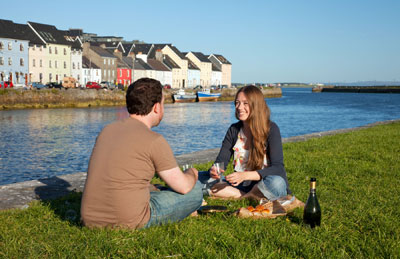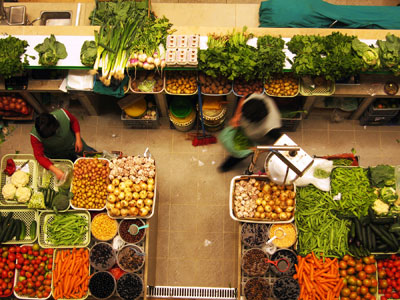Picnicking in Europe — cheap, memorable & fun
This item appears on page 60 of the January 2013 issue.
Despite France’s reputation for fine restaurants and grand cafés, one of my most memorable meals was actually a picnic on a bench in Chartres. Munching my baguette with Emmentaler cheese and sipping my box of juice in front of the floodlit cathedral, I acknowledged the bum on the next bench.
With few words, we shared a “life is good” moment in front of the gorgeous Gothic church, glowing against a starry night sky. As he reached his hand out to offer me a sip of red wine from his plastic bottle, I realized that you don’t need a Michelin-star restaurant, a charming neighborhood bistro — or even a table — to have a fine dining experience.
For me, picnics are a quintessential European experience. Though it’s still the cheapest way to eat in Europe, I don’t do it solely to save money.
I love the process: combing markets for the crustiest bread, freshest cheese and plumpest fruit; lovingly crafting a multicourse feast, accented by nice wine and punctuated by a delicious dessert, and finding that ideal perch from which to enjoy the fruits of my labor, whether it’s on the Seine watching boats glide by or in the Tiergarten observing Berliners playing Frisbee.
The best place to assemble a picnic is at a market, where you’ll usually find fair prices, local specialties and fresh produce that comes straight from the growers. Nearly every town, large or small, has at least one colorful outdoor or indoor marketplace overflowing with cheeses, meats, fresh fruits, vegetables and still-warm-out-of-the-bakery-oven bread.
Rome’s outdoors markets, such as the huge Mercato Trionfale near the Vatican Museum or Mercato Esquilino near Piazza Vittorio, clog various streets and squares every morning except Sunday. Not only are they good places to forage for a picnic, they also provide a fun and vibrant look at the city.
Barcelona’s La Boqueria sells a rainbow of fruits, veggies, meat and candies, while Madrid’s covered Mercado de San Miguel, near Plaza Mayor, has high-end vendors selling gourmet picnic produce. In Paris, Rue Cler remains my favorite pedestrian market street, offering village charm and the chance to feel the pulse of a Parisian neighborhood.
Before you dive into your favorite market, make sure you know the basics. Most markets are not self-service. You point to what you want and let the merchant bag it and weigh it for you. It’s considered rude for a customer to touch the goods.
Europeans measure things in kilos and grams (a kilo equals 2.2 pounds and has 1,000 grams). A common unit of sale for cheese or meat is 100 grams; tuck this into a chunk of bread and you have about a quarter-pounder.
Market merchants in tourist centers routinely rip off travelers. Look for posted prices, and, whether you understand them or not, act like you do; you’re more likely to be treated fairly. Observe the weighing process closely to make sure you pay the proper amount.
If you want only one or two pieces of fruit, you may run into problems, since many merchants refuse to deal in such small quantities. Simply estimate what it would cost if the merchant were to weigh it, then hold out a coin worth about that much and point to the piece you want.
Grocery stores are another good place to shop for a picnic. You’ll find everything from giant supermarkets (some of which hide out in the basements of large-city department stores) to family-owned corner stores. You can easily buy small quantities of fruits and veggies. And, like grocery stores in the US, some sell sandwiches, salads and other prepared foods to go.
Other options include bakeries, street-food stands, Asian delis, “to go” eateries and carryout chains, such as Britain’s Pret A Manger and Eat, which sell good, healthful sandwiches, salads and pastries.
After assembling your picnic, the last step is figuring out where to eat it. Proper site selection can make the difference between just another meal and le pique-nique extraordinaire.
Try to incorporate a picnic brunch, lunch or dinner into the day’s sightseeing plans. For example, have breakfast on a riverbank. Combine lunch and a siesta in a cool park to escape the early-afternoon heat. Revisit a favorite square, staircase or fountain. Or have a moveable feast: munch a lunch on a Norwegian ferry with fjord views or picnic on top of a double-decker bus, whizzing by London’s sights.
One of my favorite places to eat dinner is on a town or castle wall, enjoying a commanding view and the setting sun. Some of my all-time best picnics — and memories — have been lazy dinners accompanied by medieval fantasies in the quiet of after-hours Europe.


